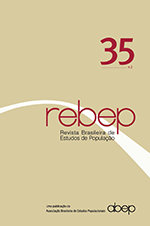Application of Brass P/F method in a context of rapid decline in adolescent fertility
DOI:
https://doi.org/10.20947/S102-3098a0052Keywords:
Brass P/F ratio, Fertility decline, Adolescent fertility, CensusAbstract
The age-specific fertility rate for women 15 to 19 years of age (f *1) declined between 2000 and 2010. It was the first time it happened since the question of children born alive in the 12 months preceding the census date was added to the Brazilian census. The substantial decline – about 30% – introduces an error in the application of the Brass P/F ratio method, by underestimating accumulated fertility up to the 20 to 24 age group (F2) and, as a consequence, overestimating the P2/F2 used in the Total Fertility Rate adjustment. In this article, we discuss this issue in detail and propose an alternative for adjusting the reference period of Brazilian census from 2010. The application of the adjusted method in this specific context estimates Total Fertility Rates similar to those estimated by use of other methods and techniques.
Downloads
References
BERQUÓ, E. S.; CAVENAGHI, S. M. Notas sobre os diferenciais educacionais e econômicos da fecundidade no Brasil. Revista Brasileira de Estudos de População, v. 31, n. 2, p. 471-482, 2014.
BRASS, W.; COALE, A. J. Methods of analysis and estimation. In: BRASS, W. et al. (Ed.). The demography of tropical Africa. 1. ed. New Jersey: Princeton University Press, 1968. p. 88-139.
BRASS, W. P/F synthesis and parity progression ratios. Advances in methods for estimating fertility and mortality from limited and defective data. London, England: Centre for Population Studies, London School of Hygiene and Tropical Medicine, 1985. p. 69-74.
CARVALHO, J. A. M. de. Aplicabildiade da técnica de fecundidade de Brass quando a fecundidade está declinando ou quando a população não é fechada. In: III ENCONTRO NACIONAL DE ESTUDOS POPULACIONAIS. Anais...Vitória-BA: Abep, 1982.
CARVALHO, J. A. M. de; GONÇALVES, G. Q.; SILVA, L. G. de C. E. Estimativas de fecundidade no Brasil, grandes regiões e unidades da federação, em 2010, a partir da aplicação da técnica P/F de Brass no contexto de rápida queda da fecundidade adolescente. Belo Horizonte: Cedeplar/UFMG (Texto para Discussão, n. 564). Disponível em: http://www.cedeplar.ufmg.br/pesquisas/td/TD 564.pdf.
CASTANHEIRA, H. C.; KOHLER, H.-P. It is lower than you think: recent total fertility rates in Brazil and possibly other Latin American countries. In: ANNUAL MEETING POPULATION ASSOCIATION OF AMERICA. Proceedings...Washington, D.C.: Population Association of America, 2016.
CAVENAGHI, S. M.; ALVES, J. E. D. Qualidade das informações sobre fecundidade no Censo Demográfico de 2010. Revista Brasileira de Estudos de População, v. 33, n. 1, p. 189-205, 2016.
FAUSTINO, S. H. R. Convergência dos resultados escolares por estratos econômicos: uma análise a partir da esperança de anos de estudo. Dissertação (Mestrado) – Universidade Federal de Minas Gerais, Belo Horizonte, 2017.
FEENEY, G. A new interpretation of Brass’ P/F ratio method applicable when fertility is declining. Disponível em: http://demographer.com/gfeeney/research-notes/1998-new-interpretationpf/1998-new-interpretation-pf.pdf. Acesso em: 23 maio. 2016.
IBGE – Instituto Brasileiro de Geografia e Estatística. Projeções da população: Brasil e Unidades da Federação. Rio de Janeiro, 2013 (Série Relatórios Metodológicos). Disponível em: ftp://ftp.ibge.gov.br/Projecao_da_Populacao/Projecao_da_Populacao_2013/srm40_projecao_da_populacao.pdf.
MARQUES, D. H. F.; CARVALHO, J. A. M. de. Uma reavaliação dos níveis da fecundidade estimados pela técnica P/F de Brass. Brasil e grandes regiões: Censos Demográficos de 1980, 1991 e 2000. Belo Horizonte: Cedeplar/UFMG, 2018 (Texto para Discussão, n. 576).
MOULTRIE, T. A. The relational Gompertz model. In: MOULTRIE, T. et al. (Ed.). Tools for demographic estimation. 1. ed. Paris: International Union for the Scientific Study of Population, 2013a. p. 54-68.
_________. Synthetic relational Gompertz models. In: MOULTRIE, T. et al. (Ed.). Tools for demographic estimation. 1. ed. Paris: International Union for the Scientific Study of Population, 2013b. p. 96-102.
MOULTRIE, T. A.; DORRINGTON, R. Sources of error and bias in methods of fertility estimation contingent on the P/F ratio in a time of declining fertility and rising mortality. Demographic Research, v. 19, p. 1635-1662, 2008.
POTTER, J. E.; SCHMERTMANN, C. P.; CAVENAGHI, S. M. Fertility and development: evidence from Brazil. Demography, v. 39, n. 4, p. 739-761, 2002.
RIGOTTI, J. I. R. The effect of varying population estimates on the calculation of enrolment rates and out-of-school rates. Montreal, Quebec, 2016. Disponível em: http://unesdoc.unesco.org/images/0024/002465/246518e.pdf.
SCHMERTMANN, C. P. et al. Bayes plus Brass: estimating total fertility for many small areas from sparse census data. Population Studies, v. 67, n. 3, p. 255-273, 2013.
SZWARCWALD, C. L.; LIBÂNIO, M. N. O.; DE FRIAS, P. G.; BORGES, P. R. S.; CORTEZ, J. J. E.; BARBOSA, L. R.; VIOLA, R. C. Busca ativa de óbitos e nascimentos no Nordeste e na Amazônia Legal: estimação das coberturas do SIM e do Sinasc nos municípios brasileiros. Saúde Brasil 2010: uma análise da situação de saúde e de evidências selecionadas de impacto de ações de vigilância em saúde. Brasília: Ministério da Saúde, Secretaria de Vigilância em Saúde, 2011. Disponível em: http://bvsms.saude.gov.br/bvs/publicacoes/saude_brasil_2010.pdf.
UNITED NATIONS. Manual X: Indirect techniques for demographic estimation. 1. ed. New York: United Nations, 1983.
ZABA, B. Use of the relational Gompertz model in analysing fertility data collected in retrospective surveys. London: Center for Population Studies / London School of Hygiene & Tropical Medicine, 1981 (Working Paper, n. 81).
Downloads
Published
How to Cite
Issue
Section
License
Papers published in Rebep are original and protected under the Creative Commons attribution-type license (CC-BY). This license allows you to reuse publications in whole or in part for any purpose, free of charge, even for commercial purposes. Any person or institution can copy, distribute or reuse the content, as long as the author and the original source are properly mentioned.

